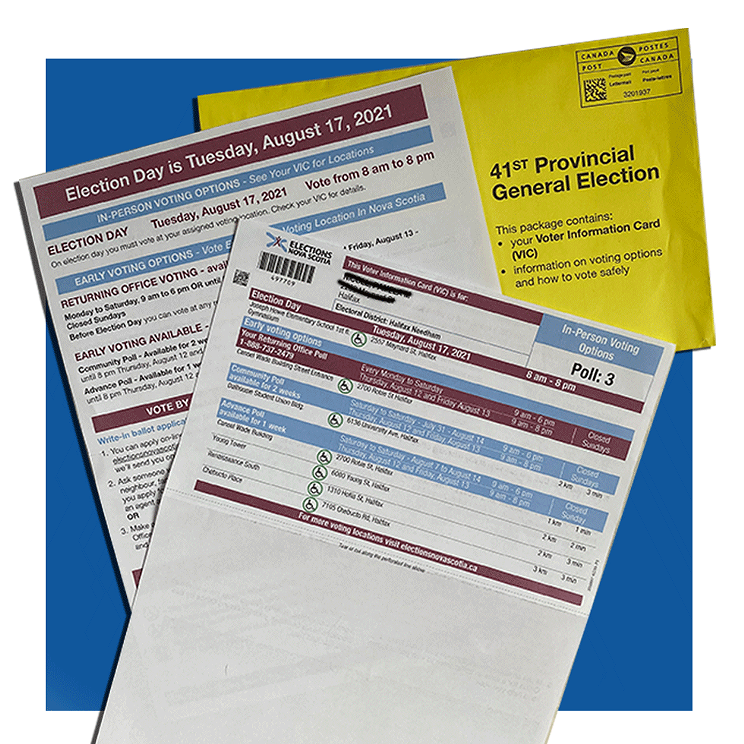If you voted in the last general election, don’t be surprised if you cast your ballot in a different riding this time around. Since 2017, Nova Scotia’s electoral map has changed significantly: the province went from having 51 electoral districts to 55, and the borders for many pre-existing ridings have shifted.
If you’re curious about what these changes mean, why they happened, and who they’re meant to serve, we’ve got you covered. Here’s a breakdown to bring you up to speed before the Tuesday, August 17 election day.
The basics
In 2019, the Liberals passed legislation that increased the number of Nova Scotia’s Members of the Legislative Assembly—that’s MLAs—from 51 to 55. Additionally, four protected districts (Argyle, Clare, Richmond and Preston) that were nixed in 2012 have been reinstated, and boundaries have been altered to reflect population shifts out of rural areas and into urban ones.
These changes are based on recommendations from the Nova Scotia Electoral Boundaries Commission, an independent group meant to revise districts based on factors like population size, geography and opinions shared during public consultation. Each province creates a new boundaries commission at least every 10 years, ensuring that electoral maps accurately reflect their constituencies.
In redrawing the map, the commission’s main purported goals were to address voter parity and representation. In short, this means making sure all voters’ ballots are weighted as equally as possible while giving minority groups (namely Acadians and African Nova Scotians) a voice.
Scott Pruysers, an assistant professor of political science at Dalhousie University, says this last bit—balancing parity and representation—is one of the main challenges a boundaries commission might face. Considering population changes and the importance placed on representation, it’s a hot-button topic this year in particular.
“It’s kind of really important to remember when you're thinking about these boundary changes, that it's not about just maximizing one democratic ideal, but a number all at once,” Pruysers says.
Rural-to-urban shifts
Many boundary lines were edited to reflect population shifts out of rural areas and into urban ones. As more people move into the HRM and its surrounding area, boundaries have to be altered to reflect larger voter populations in those urban centres and sparser ones in the country.
The results of these population changes are seen nearly everywhere on the map, but there are two key areas worth noting. There are major changes in the province’s southwest, where two new ridings have been introduced, as well as in the HRM, which has gained two new seats. (You can track these changes here, on an interactive map put out by Elections Nova Scotia.)
Pruysers explains that these changes were routine and inevitable.
“If there are fewer and fewer people in these rural ridings, and there's more and more in these urban ridings, you have to make a decision,” he says. “We either need to have more ridings, so that we can provide even more ridings to the urban centers, or we need to carve out differently and redraw those boundaries for the rural areas to preserve some of this voter parity.”
The four reinstated ridings (and their 2012 controversy)
In its 2019 report, the commission establishes that Argyle, Clare, Richmond, and Preston are central to its representation goals. The argument is that reinstating these four formerly protected districts will lead to better representation of African Nova Scotians and Acadians in government.
So, what are protected districts? And why did they get taken away in the first place?
Protected districts are meant to foster representation for marginalized communities through “exceptional” ridings. Exceptions are made based on the communities being represented; for example, a community that doesn't have a large enough population to make up its own district might get one anyways to ensure it has a voice in the election.
Protected districts are meant to work in two ways. First, they increase the chances that members of a minority group elect someone from their own community who can represent them in the legislature. Scond, they allow minority groups to participate in demography together, potentially leading to better civic engagement.
In 1991, Nova Scotia’s first boundaries commission created the protected riding of Preston “to promote more effective representation of the Black community in the Legislature.” It also chose to maintain the existing districts of Clare, Argyle and Richmond “to promote the effective representation of the Acadian community in the House of Assembly,” despite the small populations in those ridings.
In 2012, following a slew of controversy too complex to explain here, these 20-year-old districts were taken away because they had too few voters, their protected status stripped. The decision led to intense backlash, including a lawsuit from the federation that represents Acadian groups in Nova Scotia (the Fédération acadienne de la Nouvelle-Écosse) that argued their charter rights were being violated. The federation ultimately won.
Whether these districts will meaningfully increase representation for Acadians and Black Nova Scotians is up for debate. It's worth noting that all the candidates running in Preston are Black, meaning the riding is guaranteed representation from a Black politician. This is significant. It’s the first time a riding has an entirely Black roster of candidates in Nova Scotia’s history, and it might not have been possible without Preston’s reinstatement. (It’s also worth noting that only five Black MLAs have ever won seats in the province, so a guaranteed representative makes a difference.)
What is gerrymandering? And is this it?
Gerrymandering is the act of manipulating electoral districts to favour specific parties or candidates. Based on 2017 voting patterns, it looks like some of the boundary changes might favour the Liberals, especially around the HRM. But Pruysers says it would be hard to argue that gerrymandering had occurred here. All of these changes were made with good reason, and some with historical precedent.
“These four protected ridings are clearly for communities of interest that have longstanding communities of interests within Nova Scotia, communities who've been here for literally hundreds of years,” he says. “As well as then the population changes that are undeniably happening, right? More urbanization, fewer and fewer people living in rural parts.”
How will these changes impact the election?
Interestingly! This is an election with a lot of changes—new boundaries, more MLAs, 13 incumbents who’ve chosen not to run again. It’ll be neat to see how it all plays out in the coming weeks.
One effect Pruysers predicts is that we’ll see many new candidates winning seats.
“We're definitely going to see a lot of new faces in the legislature,” he says, “not just because of the additional four seats, but because of all these incumbents not running as well.”




